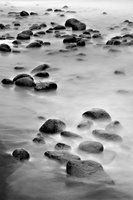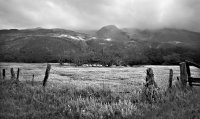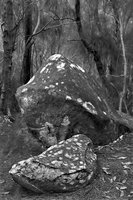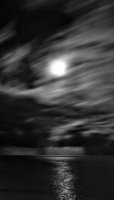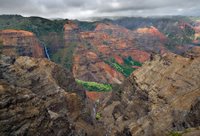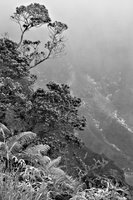
While on a recent reconnaissance mission for a new image series, I experienced a mini-epiphany with regard to my (embarrassingly slow!) maturation as an artist. Before I expand on this muse, I need to briefly explain what I mean by "reconnaissance " and "image series"...by "reconnaissance" I mean a scouting out of potential photo sites: an excursion to a new park, a farm, a garden, or an out of the way road. Sometimes I go with my camera; sometimes I deliberately choose not to, and instead just walk around a place (with hands clasped behind my back, as my artist dad used to do as though it were genetically prescribed, which in his case it might well have been!) to get the
feel of a new place. By "image series" I mean the set of photos that, by design (though chance also plays a vital part), revolve around a single theme: portals, light, reflections, complexity, decay,...
And so, on to my muse...I was on my way this past weekend to reconnoiter a local Russian Orthodox Church for a new image series called
Light & Spirit, only to find it locked, with no one around to open it. As I started on my way back home, I noticed that I was not far from an
old haunt of mine, a place I took about a dozen trips to while capturing images for a series eventually called
"Entropic Melodies" (a few of which wound up in B&W Magazine last year). I have many fond memories of spending many wonderfully creative hours prowling around that place. But, despite having a few unexpected hours at my disposal on the heels of discovering a locked church,
I had absolutely no desire to stop by my old haunt to capture a few photographs!
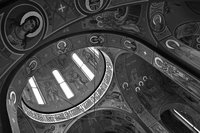
It was upon my honestly asking myself
"Why didn't I stop to take some pictures?" (while waiting, ironically, at a stop light) that I had my sudden epiphany. I did not stop because my old haunt is no longer an active part of my creative landscape. I had, in short,
moved on. The spark that lights my photography at a given place and time had been ignited - and is burning - but
elsewhere. And it is that spark that drives my work.
My photography has, in recent years, slowly evolved from my being content to "shoot away" at will at a beach or park, with no specific artistic "goal" in mind other than to maybe capture a nice image or two, to a point where, if I have not managed to capture a
series of strong enough images to convey something (ala Steiglitz or Minor White) of my inner state of mind (soul) while taking them, I am
considerably less than satisfied.
I yearn to tell a deeper story!
The keys here are:
(1) Recognizing, and being able to communicate, something aesthetically deeper than just the representational "surface layer" of a given image, and
(2) Imagining, and being able to use, a
series of images to convey something of my
inner experience of a place, as I am shooting it.
Thus, I am no longer content to "merely" capture a mysterious ethereal glow to an otherwise withered old window; I need to use that image, and another, and a third, and perhaps a dozen more like it (or entirely different from it!) to weave a still more mysterious narrative of what I
felt (and maybe a bit of what I
thought!) as I was transfixed on training my camera on withered old windows.

In trying to place my mini-epiphany-inducing locked-Church experience this weekend into a broader context, it occured to me that
all photographers - indeed, perhaps
all artists - inevitably go through some version of the following basic stages of what might suggestively be called the
Eightfold Way of an artist:
(Stage 1) One learns the technical aspects of his/her craft. In the case of a photographer, this amounts to learning how to use a camera (the meaning of an f-stop, what ASA/ISO means, how to properly meter a scene, and so on), and learning to use a darkroom (analog or digital) to produce prints. The emphasis in this stage is on the formal, mechanical aspects of an art (which is not quite an "art"). The lessons are stored in short-term memory, and must often be practiced to the point of tedium in order to commit them to long term memory that, eventually, renders them automatic.
(Stage 2) Once the mechanical has become second nature, the first hint of real art appears. The basic tools of the craft are first used as tools of the trade, though perhaps still in rudimentary fashion. The camera is used to record the "objects" of the world that are of interest to the budding artist: a person, a flower, a tree, and so on. But little or no attention is given, at this stage, to anything other than a technically correct "capture" of an image; and a representational one at that. It is rare for a budding artist to skip this representational stage and move directly to an expressionist, or even abstract, rendering of the world.
(Stage 3) In the third stage, the emerging artist takes his/her first tentative steps towards using (the, by now, technically well executed) images to express something uniquely of themselves. It is not necessarily "timeless art" in the tradition of an Ansel Adams (since most artists will never even come close to achieving this lofty ideal); but it is "art" in the sense that the artist, having now mastered the tools of his/her trade, now uses them mindfully to convey an artful message. The image of a tree ceases to be merely a representation of a "pretty tree" and becomes, instead, a personal expression of "using the photographic capture of a tree to communicate X", where "X" is a message of the artist's own choosing. Stage three is both an "easy" step to take (at least for those meant to live a life of art); and a profoundly hard one to take naturally (since even the most committed artists often have a hard time disentangling what others expect them to create and what they themselves need to create). No one can make it to Stage 4 (and higher) without stumbling through the Stage 3 roadblock.
(Stage 4) The fourth stage is a deeper imprint of the process started in stage 3. Where stage 3 sees the artist use his/her craft to communicate an artful message, stage four invites the artist to develop a personal language that uses outward forms (captured by the camera) to express inner realities. Thus, stage 4 is where the objective meets the subjective for the first time. A found/created image retains its representational form, but is infused with the first light of transcendence by its conveyance of distinctly non-representational inner meaning. A given image is used to reflect the artist's inner experience of the context for the image at the instant of capture; think of Steiglitz's "equivalents" or Minor White's Zen-like approach to using photography as a probe of his inner self).
(Stage 5) Stage 5 (which is where, if I'm in a particularly happy mood, I allow myself to believe I'm taking a tentative step toward) is where the photographer first turns his/her attention to using a
series of images to communicate - and share - a broader, deeper, experience of some meaningful reality in space and time. In short, to use images as an experiential, narrative grammar that may be used to recreate and communicate something of what the photographer felt while being in a place a camera for a time longer than an instant. When a photographer reaches stage 5, a single image no longer seems to suffice, and even a few feel stifling and incomplete. The photographer now actively seeks narratives with his pictures, and tends to use multiple images to communicate deeper experiences.
(Stage 6) As Stage 4 is a deeper imprint of stage 3, all successive stages from stage 5 and higher are essentially deeper imprints of the stages below them. Having mastered (by stage 5) his/her own creative grammar, the artist in stage 6 moves on to develop his/her own artistic language. Multiple series of images are still used, and the "subject matter" remains essentially the same, but the creative product is a subtly more profound, and resonates on many more levels (in the communication between artist and viewer). Paradoxically (though "obviously so" if you've been following the argument thus far), fewer people are able to "appreciate" what the emerging artist is using his new personal language to express; the artist need not fear this stage (though all do!), for this is also a landmark along the path to finding one's art (and soul). We cannot expect everyone to listen to what we have to say; or to hear us when we say it. The fact that fewer do than did before (at this stage) is a sign that both what we are saying and how we are saying it is becoming indelibly fused with who we are,
at our core. And we are all different.
(Stage 7) Stage 7 sees the photographer embark on an even broader vision quest to use his/her art to communicate not just inner (and intensely personal) experiences, but universal truths as well. The photograher, at this stage, wishes to use photography (and art in general) to express an (objectively invisible) universe of subjective truth. No longer confined to the space of personal narrative, the artist's creative space encroaches the whole human experience of reality. The focus is now less on physical experiences, and more - often, much more - on spiritual experiences.
Light, for example, as the pre-grammatic form of an artist's personal photographic grammar and language, is no longer just a counterpoint to tone and darkness, but is a symbolic pointer to a spiritual realm. The artist, once he/she enters stage 7, leaves the merely physical realm (and its myriad subjective descriptions), and enters the ineffably spiritual universe.
(Stage 8) Stage 8, which few artists encounter, but those that have, have
obviously done so (at least to those viewers who still understand their "language"), sees the artist, in the deepest sense possible, come home, full circle...
“Before I had studied Zen for thirty years,
I saw mountains as mountains,
and waters as waters…
When I arrived at a more intimate knowledge,
I came to the point where I saw
that mountains are not mountains,
and waters are not waters.
But now that I have got its very substance
I am at rest.
For it's just that I see mountains
once again as mountains,
and waters once again as waters.”
— Ch'uan Teng Lu,
The Way of Zen
...the artist's work is now so evolved, so personally attuned to the cosmos, and universal, that - at least on the best of days - the artist is finally able to convey
all that is with, seemingly, hardly any effort, or even artwork (!) at all. A humble little single picture, perhaps not even one of anything recognizably real, or, just as likely, of something most people would think banal, now suffices to communicate (to the best of the artist's gifts and skills)
the truths that are usually home only to young children and mystics. All is finally seen as one; and it is up to the viewer to see the one and appreciate, and marvel at, how the artist has rendered it as all.
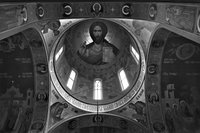 Postscript:
Postscript: I have no doubt that my dad (about whom, and about whose art, I have
written before on this Blog) is among the precious few souls who have attained the rarefied air of Stage 8. Here is his very
last painting, created sometime shortly before he died on March 30, 2002.
This from a man who amassed a lifetime's worth of skills, who sketched and painted countless landscapes and portraits, and, right up until his death, produced complex, multilayered abstracts the likes of which even Kandinsky would be proud! But his final image (that only those who did not know him would say was "obviously" drawn by a child) is a perfect -
perfect! - narrative of my dad's artful journey:
a joyous celebration of life and spirit.






